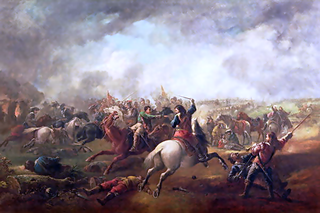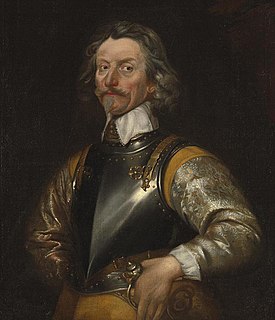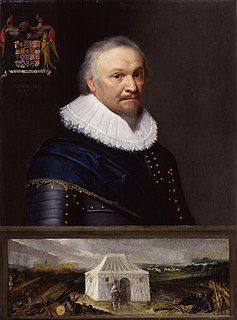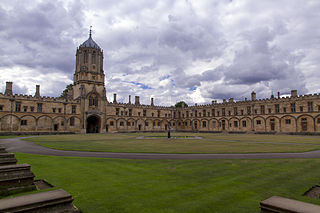Related Research Articles

The Battle of Marston Moor was fought on 2 July 1644, during the First English Civil War of 1642–1646. The combined forces of the English Parliamentarians under Lord Fairfax and the Earl of Manchester and the Scottish Covenanters under the Earl of Leven defeated the Royalists commanded by Prince Rupert of the Rhine and the Marquess of Newcastle.

The Battle of Naseby was a decisive engagement of the First English Civil War, fought on 14 June 1645 between the main Royalist army of King Charles I and the Parliamentarian New Model Army, commanded by Sir Thomas Fairfax and Oliver Cromwell. It was fought near the village of Naseby in Northamptonshire.

The New Model Army of England was formed in 1645 by the Parliamentarians in the English Civil War, and was disbanded in 1660 after the Restoration. It differed from other armies in the series of civil wars referred to as the Wars of the Three Kingdoms in that it was intended as an army liable for service anywhere in the country, rather than being tied to a single area or garrison. Its soldiers became full-time professionals, rather than part-time militia. To establish a professional officer corps, the army's leaders were prohibited from having seats in either the House of Lords or House of Commons. This was to encourage their separation from the political or religious factions among the Parliamentarians.

The Battle of Edgehill was a pitched battle of the First English Civil War. It was fought near Edge Hill and Kineton in southern Warwickshire on Sunday, 23 October 1642.

Sir Charles Lucas was an English soldier, a Royalist commander in the English Civil War.

Jacob Astley, 1st Baron Astley of Reading was a Royalist commander in the English Civil War.
The Ironsides were troopers in the Parliamentarian cavalry formed by English political leader Oliver Cromwell in the 17th century, during the English Civil War. The name came from "Old Ironsides", one of Cromwell's nicknames.

The Second Battle of Newbury was a battle of the First English Civil War fought on 27 October 1644, in Speen, adjoining Newbury in Berkshire. The battle was fought close to the site of the First Battle of Newbury, which took place in late September the previous year.

The Battle of Cheriton was an important Parliamentarian victory in the English Civil War. It took place on 29 March 1644 and resulted in the defeat of a Royalist army, which threw King Charles I onto the defensive for the remainder of the year.

The Battle of Langport was a Parliamentarian victory late in the First English Civil War which destroyed the last Royalist field army and gave Parliament control of the West of England, which had hitherto been a major source of manpower, raw materials and imports for the Royalists. The battle took place on 10 July 1645 near the small town of Langport, which lies south of Bristol.
This is the order of battle of the armies which fought on 2 July 1644 at the Battle of Marston Moor.

Horace Vere, 1st Baron Vere of Tilbury was an English military leader during the Eighty Years' War and the Thirty Years' War, a son of Geoffrey Vere and brother of Francis Vere. He was sent to the Palatinate by James I in 1620. He was created Baron Vere of Tilbury, and died without a male heir.

The Siege of 's-Hertogenbosch also known as the Siege of Bois-Le-Duc was an action in 1629, during the Eighty Years' War and the Anglo–Spanish War in which a Dutch and English army captured the city of 's-Hertogenbosch. The city had been loyal to the King of Spain since 1579 and was part of the Spanish Netherlands.
The Eastern Association of counties was a Parliamentarian organisation during the English Civil War. It provided and administered an army which eventually became a mainstay of the Parliamentarian military effort towards the end of 1644.

The second and longest Siege of Worcester( 21 May – 23 July 1646) took place towards the end of the First English Civil War, when Parliamentary forces under the command of Thomas Rainsborough besieged the city of Worcester, accepting the capitulation of the Royalist defenders on 22 July. The next day the Royalists formally surrendered possession of the city and the Parliamentarians entered Worcester 33 days after the siege began.
The Relief of Newark was a Royalist victory during the First English Civil War. It was a personal victory for Prince Rupert of the Rhine, and it resulted in the Royalists holding Newark-on-Trent until very near the end of the war.

The Siege of Oxford refers to the English Civil War military campaigns waged to besiege the Royalist controlled city of Oxford, involving three short engagements over twenty-five months, which ended with a Parliamentarian victory in June 1646.

Cornwall played a significant role in the English Civil War, being a Royalist enclave in the generally Parliamentarian south-west.

The Storming of Bristol took place on 26 July 1643, during the First English Civil War. The Royalist army under Prince Rupert of the Rhine, King Charles's nephew and lieutenant general, captured the important city and port of Bristol from its weakened Parliamentarian garrison. The city remained under Royalist control until the second siege of Bristol in September of 1645.
1645 was the fourth year of the First English Civil War. By the beginning of 1645 the war was going badly for Charles I and the campaigns of 1645 did not see a recovery in his prospects.
References
This article includes a list of references, related reading or external links, but its sources remain unclear because it lacks inline citations .(December 2014) (Learn how and when to remove this template message) |
- Roberts, Keith; Cromwell's War Machine, (Pen & Sword Military: Barnsley, 2005) ISBN 1-84415-094-1
- Young, Peter; Marston Moor 1644: The Campaign and the Battle (Kineton: Roundwood, 1970)